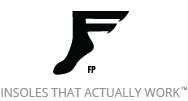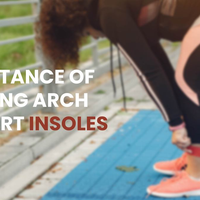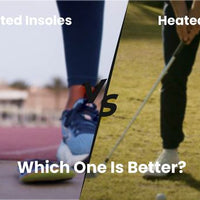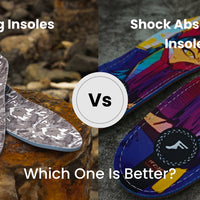Are Insoles Good for Running? Here’s How To Choose the Right Ones

Running is one of the most popular forms of exercise, but the constant impact on hard surfaces can strain your feet, ankles and legs over time. This can lead to the development of various foot conditions and injuries, making your runs painful and unpleasant. As you look for a solution, you'll likely see a common debate among runners: Are insoles good for running?
Some runners swear by using them, while others don't think they're worth the cost. We'll dive into all things running insoles, covering their pros and cons, signs you might need them and more. Whether you're lacing up for the first time or improving your performance, you’ll discover whether running insoles are the right choice for you.
What Are Running Insoles?
Running insoles, also known as shoe inserts, provide extra cushioning for runners. Every shoe has a built-in insole, a thin removable layer between your foot and the shoe. But this is just a sock liner for basic comfort; it doesn't offer true support.
Running insoles are engineered with a focus on durability and support. They absorb shock during each stride, promote a more stable foot position and help reduce the risk of common running-related injuries.
There are two main types of running insoles: supportive orthotics insoles and cushioned insoles. Supportive orthotic insoles feature rigid or semi-rigid arch support and pronounced heel cups to stabilize the foot's shape. Cushioned insoles focus on providing flexible arch support and shock absorption through padded cushioning rather than a rigid orthotic material.
Quality running insoles typically cost $40 – $70. Running insoles are different from custom orthotics, which are specifically molded to match the exact contours of your feet and are typically more expensive.
Signs You Might Need Running Insoles
How can you tell if running insoles are right for you? There are several key signs and symptoms to pay attention to that may indicate your feet need additional support:
- Foot pain during or after runs: Pay attention to if you regularly experience foot pain during or after running, especially sharp or lingering pain in the arches or heels beyond typical muscle soreness. This could manifest as stabbing sensations, numbness or aching even after your body recovers from the run. Don't ignore recurring foot pain — it's a clear indicator you may need more tailored support from insoles.
- Uneven shoe wear: Look closely at the tread and edges of your running shoe soles. Excessive wear on the inner or outer edges shows your feet are excessively rolling too far inward or outward as you run. Known as overpronation and supination (or underpronation), this uneven pressure distribution over months and miles can lead to foot problems, shin splints and poorer performance. If you notice more wear on one side or spot, insoles can help correct your gait and evenly distribute impact.
- Flat feet or high arches: Flat feet lack arch structure, leading to overpronation and poor stability that causes pain without proper arch support from insoles. High arches lack natural shock absorption, so heavy impact may lead to discomfort and plantar fasciitis without cushioned insoles. Whether you have low or high arches, insoles provide customized support and comfort matched to your arch type.
- Recurring injuries: Insoles can aid recovery from chronic injuries or overuse issues like shin splints, runner’s knee and hip/back pain by improving alignment and absorbing shock — so your joints don’t have to. They help address the root causes (like overpronation) that contribute to injuries reoccurring.

Are Insoles Good for Running?
Benefits of Using Insoles for Running
Enhanced foot support and shock absorption: Insoles provide cushioning and support to absorb impact and evenly distribute pressure for enhanced comfort. This absorbs impact from the repetitive pounding of running, rather than your feet and joints absorbing all the shock. Proper shock absorption in insoles minimizes fatigue and injury risk from high-impact activities.
Improved running posture and alignment: Insoles can correct problems such as overpronation by supporting the arch and promoting an ideal foot strike position. Realigning the ankles, knees and hips helps improve overall biomechanics and running form. Insoles also align the body properly, reducing the risk of imbalances or injury.
Injury prevention: Insoles help reduce the risk of injuries by providing extra support, stability and cushioning to maintain foot alignment and arch support. This helps prevent issues like plantar fasciitis and shin splints by reducing strain on joints, tendons and bones. Insoles absorb shock and support the arches even as foot muscles fatigue, preventing arch collapse that can lead to injury.
Extended shoe lifespan: The extra layer of cushioning from insoles provides additional padding underfoot that softens the blow to shoe midsoles and outsoles with each step. This protection reduces wear and tear that can degrade shoe components over time. By absorbing some of the impact, insoles prolong the lifespan of running shoes by minimizing the breakdown of foam and rubber materials.
Drawbacks of Using Insoles for Running
Altered running economy: Running economy refers to the oxygen cost of running at a given speed; a better economy allows you to run faster for longer. Research shows insoles can worsen running economy by limiting the foot arch's natural recoil, forcing leg muscles to work harder. However, insoles can improve performance through better alignment, endurance and injury prevention.
Decreased natural foot strength: Over time, relying on insoles may weaken your foot strength. When your feet become dependent on the support provided by insoles, the foot's intrinsic muscles can weaken since they are not being used to stabilize and propel the body forward. Targeted foot stretches and exercises can help maintain strength while using insoles.
Cost considerations: Quality running insoles can be expensive initially. The recurring cost of replacing insoles as they wear down also adds to the overall expense. However, many runners feel this investment is worth it for pain-free running. Opting for durable insole materials can maximize longevity and help get the most value over time.
Choosing the Right Insole for Your Needs
Finding the perfect insole is not just about function; it's about feeling good on your runs. No matter what you choose, comfort is the most important factor. But here are a few other factors that will help you narrow down which insole is best for you:
Arch type: When choosing insoles, determine whether you have a flat, medium or high arch type. Flat arches need maximum support insoles to prevent overpronation, while high arches require cushioned insoles for shock absorption. Medium arches are well-balanced, so avoid too high or too low insoles. With medium arches, you’ll mainly be looking for comfort and cushioning, rather than correcting arch support issues.
How you move: Your gait, or how your feet move during each stride, is critical in choosing the correct insole. Your stride will usually fall into one of three categories: overpronation, neutral gait or supination (or underpronation).
Proper sizing: Size your insoles to fit both your foot and shoe size. Most insoles come in size ranges and can be trimmed down to perfectly fit your shoes. Choose based on your foot measurements or specific shoe size.
Padding and support: Factor in padding and support requirements based on your needs. For example, runners typically require ample heel and forefoot padding as well as arch and heel support to assist with gait mechanics.
When researching insoles, people may recommend custom orthotics rather than over-the-counter insoles. Both have their pros and cons:
Custom orthotics: Custom orthotics are tailor-made to fit your unique foot shape, offering unmatched personalization. Custom orthotics may be your answer if you have complex biomechanical problems or chronic conditions. Custom orthotics costs vary widely depending on your specific needs and preferences, but they will be more expensive than over-the-counter insoles.
Over-the-counter insoles: These insoles are pre-made and easily accessible in stores. They cater to various foot types and conditions, making them a convenient choice for many runners. However, they aren't personalized like custom orthotics and may not meet your unique needs.

How To Test if Insoles Are Right for You
Finding the ideal insoles for your needs requires taking the time to test out different options properly. Don't just buy a random pair and assume they'll work. Plan to experiment with insoles on shorter runs first to see how they feel in action before relying on them for long distances.
As you try different shoe and insole combinations, pay close attention to differences in comfort, foot pain, gait stability and shock absorption. The right insole will likely improve your running experience — reducing painful pressure points and aligning your body. However, an ill-fitting insole may chafe, feel awkward or not alleviate pain and other issues. Even worse, the wrong insole can worsen your problems instead of improving them.
It's also wise to consult a podiatrist or running specialist for expert insight. They can watch you walk and run, assess your feet and recommend insoles suited for your needs and foot type. With both thorough testing yourself and guidance from the experts, you'll find the insoles that have you running comfortably mile after mile.
Take Your Runs To The Next Level with FP Insoles
When considering insoles, focus on your needs rather than a one-size-fits-all approach. Properly fitted insoles can provide valuable arch support, stability and shock absorption, but ill-fitting insoles may cause discomfort or fail to address issues. To determine if insoles are right for you, seek expert advice from a podiatrist or other specialist for personalized recommendations based on your gait and foot type.
At FP Insoles, we know finding the right insole is crucial for injury-free, comfortable running. Unlike other brands, FP Insoles absorb over 90% of your foot's impact thanks to our innovative NASA-approved materials. Their superior shock absorption transforms running from fatiguing and painful to comfortable and energizing.
Whatever your needs, FP Insoles can help. Our Gamechangers Custom Orthotics insoles are ideal for flat and low arches, letting you mold the insole to your exact foot shape for personalized arch support. Our Kingfoam insoles provide the same shock absorption for mid to high arches, offering excellent comfort for those without biomechanical issues.
With FP Insoles as your running partner, you can say goodbye to discomfort and hello to personal bests. Explore our complete collection of insoles designed to keep up with your active lifestyle.





